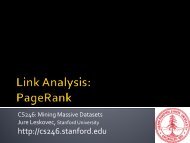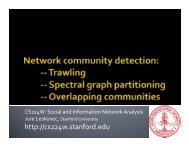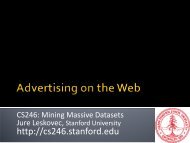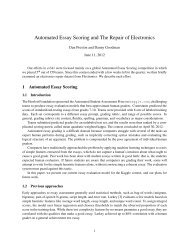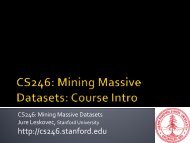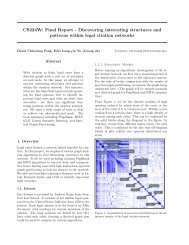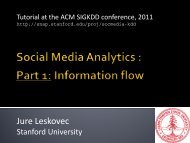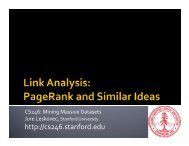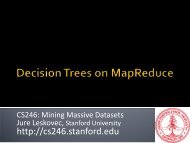data mining - SNAP - Stanford University
data mining - SNAP - Stanford University
data mining - SNAP - Stanford University
Create successful ePaper yourself
Turn your PDF publications into a flip-book with our unique Google optimized e-Paper software.
CS246: Mining Massive Datasets<br />
Jure Leskovec, <strong>Stanford</strong> <strong>University</strong><br />
http://cs246.stanford.edu
Instructor:<br />
Jure Leskovec<br />
TAs:<br />
Aditya Parameswaran<br />
Bahman Bahmani<br />
Peyman Kazemian<br />
1/3/2011 Jure Leskovec, <strong>Stanford</strong> C246: Mining Massive Datasets<br />
2
Course website:<br />
http://cs246.stanford.edu<br />
Lecture slides (~30min before the lecture)<br />
Announcements, homeworks, solutions<br />
Readings!<br />
Readings: Book Mining of Massive Datasets<br />
by Anand Rajaraman nad Jeffrey D. Ullman<br />
Fee online:<br />
http://i.stanford.edu/~ullman/mmds.html<br />
1/3/2011 Jure Leskovec, <strong>Stanford</strong> C246: Mining Massive Datasets 3
Send questions/clarifications to:<br />
cs246-win1011-staff@lists.stanford.edu<br />
Course mailing list:<br />
cs246-win1011-all@lists.stanford.edu<br />
If you are auditing send us email and we will<br />
subscribe you!<br />
Office hours:<br />
Jure: Tuesdays 9-10am, Gates 418<br />
See course website for TA office hours<br />
1/3/2011 Jure Leskovec, <strong>Stanford</strong> C246: Mining Massive Datasets 4
4 Longer homeworks: 30%<br />
theoretical and programming/<strong>data</strong> analysis<br />
questions<br />
All homeworks (even if empty) must be handed in<br />
Start early!!!!<br />
Short weekly quizes: 20%<br />
Short e-quizes on Gradiance<br />
No late days!<br />
Final Exam: 50%<br />
It’s going to be fun and hard work <br />
1/3/2011 Jure Leskovec, <strong>Stanford</strong> C246: Mining Massive Datasets<br />
5
Date Out In<br />
1/5 HW1<br />
1/19 HW2 HW1<br />
2/2 HW3 HW2<br />
2/16 HW4 HW3<br />
3/2 HW4<br />
No class: 1/17: Martin Luther King Jr.<br />
2/21: President’s day<br />
2 recitations:<br />
Review of basic concepts<br />
Installing and working with Hadoop<br />
1/3/2011 Jure Leskovec, <strong>Stanford</strong> C246: Mining Massive Datasets 6
Discovery of useful, possibly unexpected,<br />
patterns in <strong>data</strong><br />
Subsidiary issues:<br />
Data cleansing: detection of bogus <strong>data</strong><br />
E.g., age = 150<br />
Entity resolution<br />
Visualization: something better than<br />
megabyte files of output<br />
Warehousing of <strong>data</strong> (for retrieval)<br />
7
Databases:<br />
concentrate on large-scale<br />
(non-main-memory) <strong>data</strong><br />
AI (machine-learning):<br />
concentrate on complex methods,<br />
usually small <strong>data</strong><br />
Statistics:<br />
concentrate on models<br />
8
To a <strong>data</strong>base person, <strong>data</strong>-<strong>mining</strong> is an<br />
extreme form of analytic processing –<br />
queries that examine large amounts of <strong>data</strong>:<br />
Result is the <strong>data</strong> that answers the query.<br />
To a statistician, <strong>data</strong>-<strong>mining</strong> is the<br />
inference of models:<br />
Result is the parameters of the model.<br />
9
Much of the course will be devoted to<br />
ways to <strong>data</strong> <strong>mining</strong> on the Web:<br />
Mining to discover things about the Web<br />
E.g., PageRank, finding spam sites<br />
Mining <strong>data</strong> from the Web itself<br />
E.g., analysis of click streams, similar products at<br />
Amazon, making recommendations.<br />
1/3/2011 Jure Leskovec, <strong>Stanford</strong> C246: Mining Massive Datasets 10
Much of the course will be devoted to<br />
Large scale computing for <strong>data</strong> <strong>mining</strong><br />
Challenges:<br />
How to distribute computation?<br />
Distributed/parallel programming is hard<br />
Map-reduce addresses all of the above<br />
Google’s computational/<strong>data</strong> manipulation model<br />
Elegant way to work with big <strong>data</strong><br />
1/3/2011 Jure Leskovec, <strong>Stanford</strong> C246: Mining Massive Datasets 11
Association rules, frequent itemsets<br />
PageRank and related measures of<br />
importance on the Web (link analysis)<br />
Spam detection<br />
Topic-specific search Recommendation systems<br />
E.g., what should Amazon suggest you buy?<br />
Large scale machine learning methods<br />
SVMs, decision trees, …<br />
1/3/2011 Jure Leskovec, <strong>Stanford</strong> C246: Mining Massive Datasets<br />
12
Min-hashing/Locality-Sensitive Hashing<br />
Finding similar Web pages<br />
Clustering <strong>data</strong><br />
Extracting structured <strong>data</strong> (relations)<br />
from the Web<br />
Managing Web advertisements<br />
Mining <strong>data</strong> streams<br />
1/3/2011 Jure Leskovec, <strong>Stanford</strong> C246: Mining Massive Datasets<br />
13
Algorithms:<br />
Dynamic programming, basic <strong>data</strong> structures<br />
Basic probability (CS109 or Stat116):<br />
Moments, typical distributions, regression, …<br />
Programming (CS107 or CS145):<br />
Your choice, but C++/Java will be very useful<br />
We provide some background, but the class<br />
will be fast paced<br />
1/3/2011 Jure Leskovec, <strong>Stanford</strong> C246: Mining Massive Datasets 14
CS345a: Data <strong>mining</strong> got split into 2 course:<br />
CS246: Mining massive <strong>data</strong>sets:<br />
Methods oriented course<br />
Homeworks (theory & programming)<br />
No massive class project<br />
CS341: Advanced topics in <strong>data</strong> <strong>mining</strong>:<br />
Project oriented class<br />
Lectures/readings related to the project<br />
Unlimited access to Amazon EC2 cluster<br />
We intend to keep the class to be small<br />
Taking CS246 is basically essential<br />
1/3/2011 Jure Leskovec, <strong>Stanford</strong> C246: Mining Massive Datasets 15
Lots of <strong>data</strong> is being collected<br />
and warehoused<br />
Web <strong>data</strong>, e-commerce<br />
purchases at department/<br />
grocery stores<br />
Bank/Credit Card<br />
transactions<br />
Computers are cheap and powerful<br />
Goal:<br />
Provide better, customized services<br />
(e.g. in Customer Relationship Management)<br />
1/3/2011 Jure Leskovec, <strong>Stanford</strong> C246: Mining Massive Datasets<br />
16
Data collected and stored at<br />
enormous speeds (GB/hour)<br />
remote sensors on a satellite<br />
telescopes scanning the skies<br />
microarrays generating gene<br />
expression <strong>data</strong><br />
scientific simulations<br />
generating terabytes of <strong>data</strong><br />
Traditional techniques infeasible<br />
for raw <strong>data</strong><br />
Data <strong>mining</strong> helps scientists<br />
in classifying and segmenting <strong>data</strong><br />
in Hypothesis Formation<br />
1/3/2011 Jure Leskovec, <strong>Stanford</strong> C246: Mining Massive Datasets 17
There is often information “hidden” in the <strong>data</strong> that is<br />
not readily evident<br />
Human analysts take weeks to discover useful<br />
information<br />
Much of the <strong>data</strong> is never analyzed at all<br />
4,000,000<br />
3,500,000<br />
3,000,000<br />
2,500,000<br />
2,000,000<br />
1,500,000<br />
1,000,000<br />
500,000<br />
0<br />
The Data Gap<br />
Total new disk (TB) since 1995<br />
Number of<br />
analysts<br />
1995 1996 1997 1998 1999<br />
1/3/2011 Jure Leskovec, <strong>Stanford</strong> C246: Mining Massive Datasets<br />
18
Non-trivial extraction of implicit, previously<br />
unknown and useful information from <strong>data</strong><br />
1/3/2011 Jure Leskovec, <strong>Stanford</strong> C246: Mining Massive Datasets<br />
19
A big <strong>data</strong>-<strong>mining</strong> risk is that you will<br />
“discover” patterns that are meaningless.<br />
Bonferroni’s principle: (roughly) if you look in<br />
more places for interesting patterns than your<br />
amount of <strong>data</strong> will support, you are bound to<br />
find crap.<br />
1/3/2011 Jure Leskovec, <strong>Stanford</strong> C246: Mining Massive Datasets 20
A parapsychologist in the 1950’s<br />
hypothesized that some people had<br />
Extra-Sensory Perception<br />
He devised an experiment where<br />
subjects were asked to guess 10 hidden<br />
cards – red or blue<br />
He discovered that almost 1 in 1000 had ESP –<br />
they were able to get all 10 right<br />
1/3/2011 Jure Leskovec, <strong>Stanford</strong> C246: Mining Massive Datasets<br />
21
He told these people they had ESP and called<br />
them in for another test of the same type<br />
Alas, he discovered that almost all of them<br />
had lost their ESP<br />
What did he conclude?<br />
He concluded that you shouldn’t tell people<br />
they have ESP; it causes them to lose it <br />
1/3/2011 Jure Leskovec, <strong>Stanford</strong> C246: Mining Massive Datasets<br />
22
Overlaps with machine learning, statistics,<br />
artificial intelligence, <strong>data</strong>bases, visualization<br />
but more stress on<br />
scalability of number<br />
of features and instances<br />
stress on algorithms and<br />
architectures<br />
automation for handling large,<br />
heterogeneous <strong>data</strong><br />
Statistics/<br />
AI<br />
Data Mining<br />
Database<br />
systems<br />
Machine Learning/<br />
Pattern<br />
Recognition<br />
1/3/2011 Jure Leskovec, <strong>Stanford</strong> C246: Mining Massive Datasets<br />
23
Prediction Methods<br />
Use some variables to predict unknown or<br />
future values of other variables.<br />
Description Methods<br />
Find human-interpretable patterns that<br />
describe the <strong>data</strong>.<br />
1/3/2011 Jure Leskovec, <strong>Stanford</strong> C246: Mining Massive Datasets<br />
24
Given <strong>data</strong>base of user preferences,<br />
predict preference of new user<br />
Example:<br />
Predict what new movies you will like based on<br />
your past preferences<br />
others with similar past preferences<br />
their preferences for the new movies<br />
Example:<br />
Predict what books/CDs a person may want to buy<br />
(and suggest it, or give discounts to tempt<br />
customer)<br />
1/3/2011 Jure Leskovec, <strong>Stanford</strong> C246: Mining Massive Datasets<br />
25
Detect significant deviations<br />
from normal behavior<br />
Applications:<br />
Credit Card Fraud Detection<br />
Network Intrusion<br />
Detection<br />
1/3/2011 Jure Leskovec, <strong>Stanford</strong> C246: Mining Massive Datasets<br />
26
Supermarket shelf management:<br />
Goal: To identify items that are bought together by<br />
sufficiently many customers.<br />
Approach: Process the point-of-sale <strong>data</strong> collected with<br />
barcode scanners to find dependencies among items.<br />
A classic rule:<br />
If a customer buys diaper and milk, then he is likely to buy beer.<br />
So, don’t be surprised if you find six-packs stacked next to diapers!<br />
TID Items<br />
1 Bread, Coke, Milk<br />
2 Beer, Bread<br />
3 Beer, Coke, Diaper, Milk<br />
4 Beer, Bread, Diaper, Milk<br />
5 Coke, Diaper, Milk<br />
Rules Discovered:<br />
{Milk} --> {Coke}<br />
{Diaper, Milk} --> {Beer}<br />
1/3/2011 Jure Leskovec, <strong>Stanford</strong> C246: Mining Massive Datasets<br />
27
1/3/2011 Jure Leskovec, <strong>Stanford</strong> C246: Mining Massive Datasets 28
Process of semi-automatically analyzing large<br />
<strong>data</strong>sets to find patterns that are:<br />
valid: hold on new <strong>data</strong> with some certainty<br />
novel: non-obvious to the system<br />
useful: should be possible to act on the item<br />
understandable: humans should be able to<br />
interpret the pattern<br />
1/3/2011 Jure Leskovec, <strong>Stanford</strong> C246: Mining Massive Datasets<br />
29
Network intrusion detection using a<br />
combination of sequential rule discovery and<br />
classification tree on 4 GB DARPA <strong>data</strong><br />
Won over (manual) knowledge engineering<br />
approach<br />
http://www.cs.columbia.edu/~sal/JAM/PROJECT/<br />
provides good detailed description of the entire<br />
process<br />
1/3/2011 Jure Leskovec, <strong>Stanford</strong> C246: Mining Massive Datasets<br />
30
Major US bank: Customer attrition prediction<br />
Segment customers based on financial<br />
behavior: 3 segments<br />
Build attrition models for each of the 3 segments<br />
40-50% of attritions were predicted == factor of 18<br />
increase<br />
1/3/2011 Jure Leskovec, <strong>Stanford</strong> C246: Mining Massive Datasets<br />
31
Targeted credit marketing: major US banks<br />
find customer segments based on 13 months<br />
credit balances<br />
build another response model based on surveys<br />
increased response 4 times – 2%<br />
1/3/2011 Jure Leskovec, <strong>Stanford</strong> C246: Mining Massive Datasets<br />
32
Scalability<br />
Dimensionality<br />
Complex and Heterogeneous Data<br />
Data Quality<br />
Data Ownership and Distribution<br />
Privacy Preservation<br />
Streaming Data<br />
1/3/2011 Jure Leskovec, <strong>Stanford</strong> C246: Mining Massive Datasets<br />
33
Banking: loan/credit card approval:<br />
predict good customers based on old customers<br />
Customer relationship management:<br />
identify those who are likely to leave for a competitor<br />
Targeted marketing:<br />
identify likely responders to promotions<br />
Fraud detection: telecommunications, finance<br />
from an online stream of event identify fraudulent<br />
events<br />
Manufacturing and production:<br />
automatically adjust knobs when process parameter<br />
changes<br />
1/3/2011 Jure Leskovec, <strong>Stanford</strong> C246: Mining Massive Datasets<br />
34
Medicine: disease outcome, effectiveness of<br />
treatments<br />
analyze patient disease history: find relationship<br />
between diseases<br />
Molecular/Pharmaceutical:<br />
identify new drugs<br />
Scientific <strong>data</strong> analysis:<br />
identify new galaxies by searching for sub clusters<br />
Web site/store design and promotion:<br />
find affinity of visitor to pages and modify layout<br />
1/3/2011 Jure Leskovec, <strong>Stanford</strong> C246: Mining Massive Datasets<br />
35




